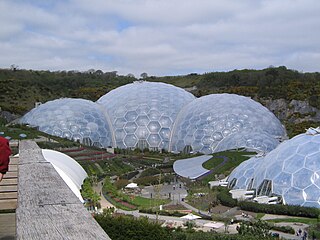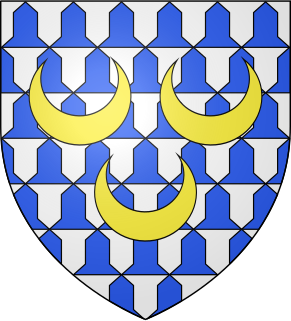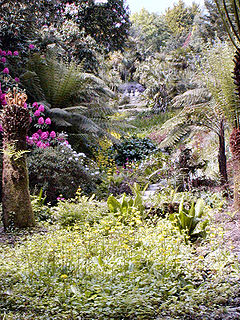This list is for notable gardens in Cornwall. It includes Botanical gardens and gardens which are on the: Register of Historic Parks and Gardens of special historic interest in England.
This list is for notable gardens in Cornwall. It includes Botanical gardens and gardens which are on the: Register of Historic Parks and Gardens of special historic interest in England.
| | This section needs expansion. You can help by adding to it. (March 2018) |
Gardens in Cornwall which are open for charity at appointed times include Boconnoc, Bonython, Bosvigo, Cotehele, Eden Project, Glendurgan, Godolphin, Heligan, Headland at Polruan, Ince Castle, Lanhydrock, Pencarrow, St Michael's Mount, Scorrier, Trebah, Trebartha, Trelissick, Trematon Castle, Trengwainton and Trewan Hall. [4]

The Eden Project is a visitor attraction in Cornwall, England, UK. The project is located in a reclaimed china clay pit, located 2 km (1.2 mi) from the town of St Blazey and 5 km (3 mi) from the larger town of St Austell.

Polruan is a small fishing village in the parish of Lanteglos-by-Fowey in Cornwall, England, United Kingdom. It is bounded on three sides by water: to the north by Pont Creek, to the west by the River Fowey and to the south by the English Channel and neighbours village Bodinnick to the north, connected by a 4-mile walk along the hill tops. Polruan is very steep and well protected from the prevailing winds and Polruan Pool is a haven for small boats.

The River Fowey is a river in Cornwall, England, United Kingdom.

In architecture, a folly is a building constructed primarily for decoration, but suggesting through its appearance some other purpose, or of such extravagant appearance that it transcends the range of usual garden buildings.
Sheriffs and high sheriffs of Cornwall: a chronological list:

The field elm cultivar Ulmus minor 'Stricta', known as Cornish elm, was commonly found in South West England and Brittany until the arrival of Dutch elm disease in the late 1960s. The origin of Cornish elm in England remains a matter of contention. It is commonly assumed to have been introduced from Brittany. It is also considered possible that the tree may have survived the ice ages on lands to the south of Cornwall long since lost to the sea. Henry thought it "probably native in the south of Ireland". Dr Max Coleman of Royal Botanic Garden Edinburgh, arguing in his 2002 paper on British elms that there was no clear distinction between species and subspecies, suggested that known or suspected clones of Ulmus minor, once cultivated and named, should be treated as cultivars, preferred the designation U. minor 'Stricta' to Ulmus minor var. stricta. The DNA of 'Stricta' has been investigated and the cultivar is now known to be a clone.

Tresco Abbey Gardens are located on the island of Tresco in the Isles of Scilly, United Kingdom. The 17 acre gardens were established by the nineteenth-century proprietor of the islands, Augustus Smith, originally as a private garden within the grounds of the home he designed and built. The gardens are designated at Grade I in the Register of Historic Parks and Gardens.

The Williams family of Caerhays, Burncoose and Scorrier were owners of mines and smelting works for several generations during the Cornish Industrial Revolution. A branch of the family settled in Port Hope, Ontario.

Cornwall is the county that forms the tip of the southwestern peninsula of England; this area has a mild and warm climate regulated by the Gulf Stream. The mild climate allows rich plant cover, such as palm trees in the far south and west of the county and in the Isles of Scilly, due to sub-tropical conditions in the summer.
John Hearle Tremayne was a member of a landed family in the cornish county of Cornwall, and owner of the Heligan estate near Mevagissey. He was a member of the UK Parliament for the constituency of Cornwall, a Justice of the peace, and High Sheriff of Cornwall in 1831. He was also the second of four successive members of the Tremayne family who are credited with the creation of the gardens around Heligan House that are now well known as the Lost Gardens of Heligan.
Great Cornish Families: A History of the People and Their Houses is a book by Crispin Gill, published in 1995. A second edition was published in 2011 (ISBN 978-0-85704-083-1). Crispin Gill, at the time of the book's publication, lived in Plymouth and was assistant editor of the Western Morning News. The book names many notable families that have featured prominently in Cornwall's history.
WildWorks is an international site-specific theatre company based in Cornwall, England.
Reverend Canon Arthur Townshend Boscawen was from 1893 the Rector of Ludgvan, Cornwall, UK, and a recreational and commercial horticulturalist who introduced the anemone as a commercial crop to Cornwall.
Presented below is an alphabetical index of articles related to Cornwall: